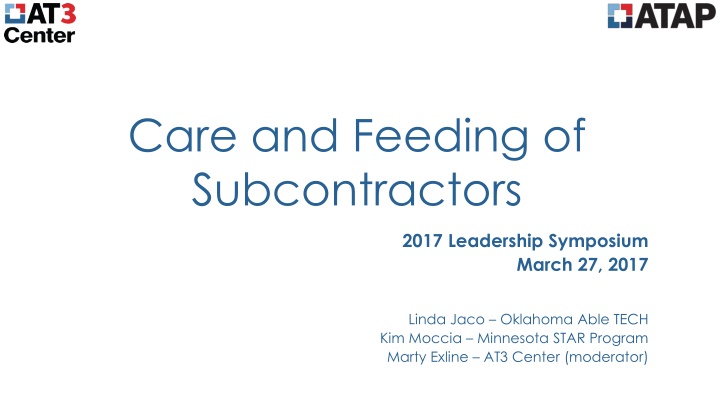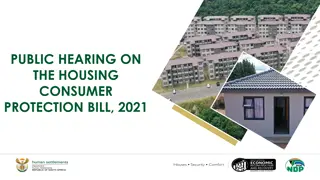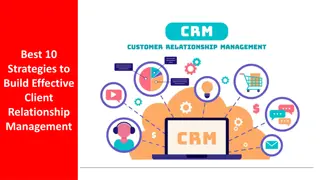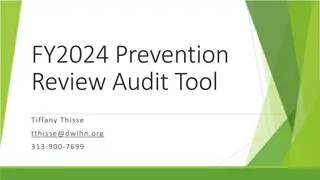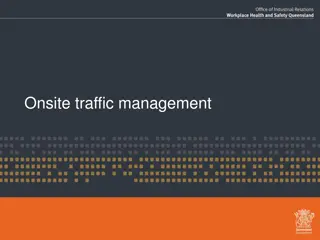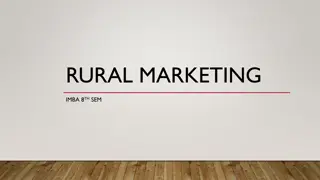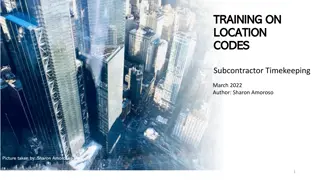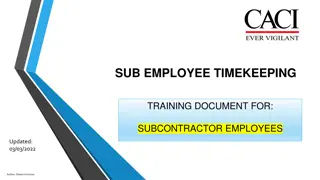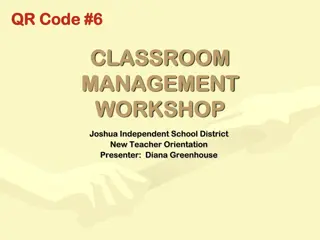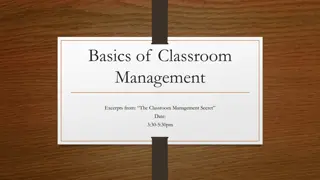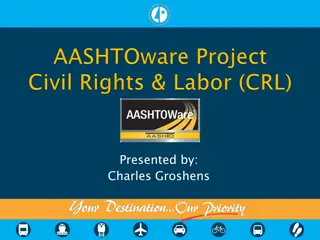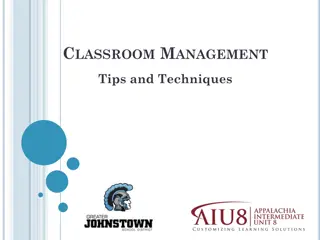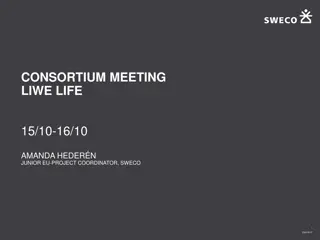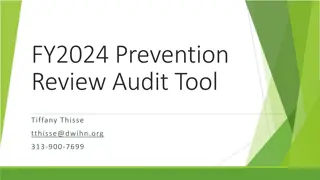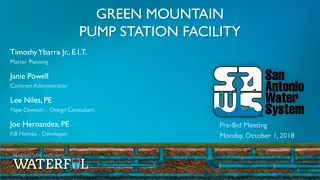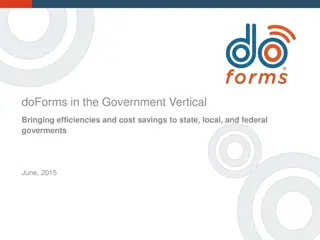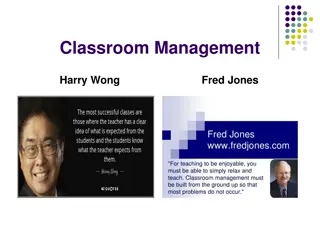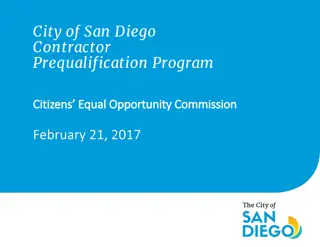Effective Subcontractor Management Strategies
Properly managing subcontractors is essential for project success. This involves clear communication, setting expectations, and establishing guidelines for effective collaboration. Learn key strategies and best practices in subcontractor management to ensure smooth project execution.
Download Presentation

Please find below an Image/Link to download the presentation.
The content on the website is provided AS IS for your information and personal use only. It may not be sold, licensed, or shared on other websites without obtaining consent from the author.If you encounter any issues during the download, it is possible that the publisher has removed the file from their server.
You are allowed to download the files provided on this website for personal or commercial use, subject to the condition that they are used lawfully. All files are the property of their respective owners.
The content on the website is provided AS IS for your information and personal use only. It may not be sold, licensed, or shared on other websites without obtaining consent from the author.
E N D
Presentation Transcript
Care and Feeding of Subcontractors 2017 Leadership Symposium March 27, 2017 Linda Jaco Oklahoma Able TECH Kim Moccia Minnesota STAR Program Marty Exline AT3 Center (moderator)
Oklahoma ABLE Tech A Collaboration with Oklahoma Partners to Offer a Statewide AT Demonstration and Short-term Loan Program
Key Players Organizations that provide direct AT-related services to Oklahomans with disabilities (i.e. hearing, vision, speech, mobility, daily living, etc.) Oklahoma ABLE Tech
Key Players (cont) Hearing Loss Association Total Source for Hearing Loss and Access OSU Department of Communication Sciences and Disorders OU John W Keys Speech and Hearing Clinic Pathways Therapy Center The Children s Center NewView (OKC and Tulsa) Handicapped Vehicle Services Newby-Vance Mobility United Access Mobility
Background Memorandum of Agreement (MOA) Developed in 2005 Need to provide an affordable, comprehensive, statewide AT demonstration and short-term loan program to Oklahomans with disabilities ABLE Tech reached out to a variety of organizations serving individuals with disabilities with the offer of AT devices that would expand and enhance service delivery options in exchange for AT demonstration and short-term loan data per the AT Act
MOA Developed Partners responsible for: Primary contact person within each organization Space to house AT Acknowledgement of partnership on marketing materials Development of operational procedures, that at a minimum, identify: Maximum AT loan term to not exceed 42 days Borrowers are responsible for returning item in same condition, excluding normal wear and tear Borrowers are responsible for the cost of repair or if not returned- the replacement of a device Demo and short-term loan reports to ABLE Tech by the 5thof each month utilizing NATADS web-based system Routine maintenance of all AT equipment
MOA Developed (cont) Participation in an annual AT inventory report Attendance at 2 annual trainings Attendance at 1 AT webinar hosted by ABLE Tech Submission of 4 annual AT success stories utilizing the ABLE Tech Success Story/Photo Release Form Completion of an AT Demonstration Survey reported in the NATADS web- based system Completion of an AT Short-term Loan Survey completed by borrower and returned with device and reported in NATADS web-based system
MOA Developed (cont) ABLE Tech responsible for: Purchasing and bar coding of all equipment ABLE Tech maintains ownership of all equipment Conduct an annual inventory with each partner ABLE Tech determines and removes any obsolete or underutilized equipment Based on available funding, ABLE Tech purchases and bar codes new AT for each partner on an annual basis Report format for success stories with release forms Provides both the AT demo and short-term loan surveys
MOA Developed (cont) ABLE Tech responsible for: Quarterly reports to ABLE Tech Advisory Council / Annual reports to ACL Monthly newsletter Development of AT webinar series Training at both mandated partner meetings
Successful Outcomes FFY 16 Data: ABLE Tech and its partners provided 4,949 AT device demonstrations to 10,133 Oklahomans across OK ABLE Tech and its partners provided 2,204 AT short- term loans to Oklahomans across OK
Questions? Contact Information: Linda Jaco Oklahoma ABLE Tech Phone: 405.744.9864 Email: linda.jaco@okstate.edu
Minnesota STAR Program Lessons Learned: Working with Subcontractors
Contract Evolution - Monitoring and Measuring Success 2005 2011 Partner Proposed 2010 Peer Review Recommendation 2011 2015 Performance Based 2016 Present Master Contract
Minnesota by the Numbers 87 Counties 73% (3.9 million) live in an urban area 11% (609,000) live in large towns 8 % (434,000) live in a rural area 7% (390,000) live in small towns 10.5% (593,700) residents have one or more disabilities Older residents more common in non-urban areas (44% rural residents are over the age of 50)
Partner Proposed Contracts Request for Proposal (RFP) Based on modified version of state professional/technical contract templates Professional service activities requested: Purchase AT Conduct demonstrations and device loans Collect data (customer survey) Submit quarterly reports Respondent required to submit Brief summary of organization highlighting its AT services, accomplishments, and goals List AT the organization will make available for demonstration/loan Describe how partnering with STAR fits into organization s overall goals
Partner Proposed Contracts (continued) Respondent required to submit Number of consumers served Service/activity proposal Geographic service area Targeted populations Past and current AT collaborations Resume of key persons Budget narrative and line-item budget Acknowledgment that key persons will attend required training Provide required assurances (federal/state)
Partner Proposed Contracts (continued) Review Process Review committee 3 to 5 advisory council members 105 Point Scale Plan of Action (40 points) Capacity/Capability (30 points) Agency Commitment (15 points) Budget (15 points) Discretionary other considerations, uniqueness, innovation (5 points) Restrictions Funds may not supplant other funding sources Indirect costs and space rental not allowed Administrative costs not to exceed $300
Partner Proposed Contracts (continued) Pros More subcontractors/partners Higher service numbers reported Cons Informal paper-based data collection Partners were allowed to use their own system Took longer/more resources to compile data and enter into master Excel sheet Incomplete reporting (non-respondent or other) Low performance measures Lack of control over AT purchased by partner with contract dollars
Performance-Based Contracts Proposals reviewed and contract awarded based, in part, on: Projection Forms Disability Type Domain (education, employment, community living) Population served Geographic region
Performance-Based Contracts Other contract changes: Agree to use NATADS to submit quarterly data Agree to submit one anecdote per quarter No longer receive funding to purchase AT May submit formal AT request, if needed
Performance-Based Contracts Initially paid: $55 per demonstration/short-term loan $70 (activities related to employment) $100 per open-ended loan Postage (varied per length and terms of contract) Travel expenses (varied per length and terms of contract)
Master Contracts Why switch? Allow potential subcontractor more time to submit RFP (deadline is January 2020) Increase number of new partners Quick access to approved subcontractors Issue work orders, as needed Worth noting: Entering into a Master Contract does not guarantee the subcontractor will be issued a work order Subcontractors can submit new proposal to add other service activities
Master Contracts Current reimbursement: $60 per demonstration/short-term loan $100 per open-ended loan Postage - will be reimbursed when the total cost for postage is over $20.00. $300 cap per quarter. Travel expenses will reimburse when travel exceeds 50 miles round trip. $300 cap per quarter.
Working with State Agencies Memorandum of Understanding with Department of Employment and Economic Development Vocational Rehabilitation Services State Services for the Blind Agency Agreement with Department of Human Services Deaf and Hard of Hearing Services
Beyond Contracts Finding Partners Establishing Procedures Training Developing and Maintaining Relationships
What Shape Are You? Circle - Triangle - Square - Squiggle - Partners are people Know your personality type Identify their personality type Remember positive partnerships embrace all shapes
Questions? Contact Kim Moccia Department of Administration/STAR Program 651-201-2297 Kim.Moccia@state.mn.us
Elements of Subcontracting Agreements Description of services to be performed (deliverables); Population to be served; Geographic area to be served Operational procedures Budget & Payment structure Set amount with targets? Performance incentives? Maximum payment Can withhold payment if sub-par?
Elements of Subcontracting Agreements Aptitude, Qualifications, Experience of Staff Appropriate space Data Reporting Invoice Periods Anecdotes / Success stories / Pictures Marketing Outreach Mention of State AT program Annual Inventory Report Maintain Equipment
Elements of Subcontracting Agreements Are you providing (Purchasing or loaning) equipment or dollars for equipment? Removing obsolete or underutilized equipment? Site Visits Training 1or 2 per year Webinars or calls for more narrowly focused Vendor visits Conferences
Beyond the Agreement Recognitions Other incentives Partners are People
Questions? Contact Information: Marty Exline AT3 Center 816-547-6577 E-mail: marty.exline@ataporg.org
